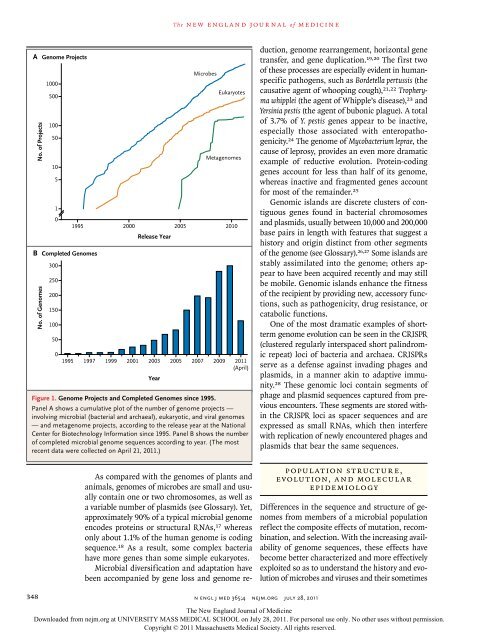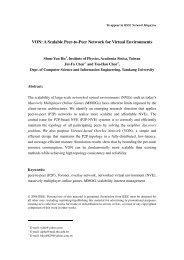Microbial Genomics and Infectious Diseases - Evernote
Microbial Genomics and Infectious Diseases - Evernote
Microbial Genomics and Infectious Diseases - Evernote
Create successful ePaper yourself
Turn your PDF publications into a flip-book with our unique Google optimized e-Paper software.
348<br />
A Genome Projects<br />
No. of Projects<br />
1000<br />
500<br />
100<br />
50<br />
10<br />
5<br />
1<br />
0<br />
B Completed Genomes<br />
No. of Genomes<br />
300<br />
250<br />
200<br />
150<br />
100<br />
50<br />
0<br />
1995 2000 2005 2010<br />
Release Year<br />
1995 1997 1999 2001 2003 2005<br />
Year<br />
As compared with the genomes of plants <strong>and</strong><br />
animals, genomes of microbes are small <strong>and</strong> usually<br />
contain one or two chromosomes, as well as<br />
a variable number of plasmids (see Glossary). Yet,<br />
approximately 90% of a typical microbial genome<br />
encodes proteins or structural RNAs, 17 whereas<br />
only about 1.1% of the human genome is coding<br />
sequence. 18 As a result, some complex bacteria<br />
have more genes than some simple eukaryotes.<br />
<strong>Microbial</strong> diversification <strong>and</strong> adaptation have<br />
been accompanied by gene loss <strong>and</strong> genome re-<br />
T h e n e w e ngl a nd j o u r na l o f m e dic i n e<br />
Microbes<br />
Eukaryotes<br />
Metagenomes<br />
2007 2009 2011<br />
(April)<br />
Figure 1. Genome Projects <strong>and</strong> Completed Genomes since 1995.<br />
Panel A shows a cumulative plot of the number of genome projects —<br />
involving microbial (bacterial <strong>and</strong> archaeal), eukaryotic, <strong>and</strong> viral genomes<br />
— <strong>and</strong> metagenome projects, according to the release year at the National<br />
Center for Biotechnology Information since 1995. Panel B shows the number<br />
of completed microbial genome sequences according to year. (The most<br />
recent data were collected on April 21, 2011.)<br />
n engl j med 365;4 nejm.org july 28, 2011<br />
duction, genome rearrangement, horizontal gene<br />
transfer, <strong>and</strong> gene duplication. 19,20 The first two<br />
of these processes are especially evident in humanspecific<br />
pathogens, such as Bordetella pertussis (the<br />
causative agent of whooping cough), 21,22 Tropheryma<br />
whipplei (the agent of Whipple’s disease), 23 <strong>and</strong><br />
Yersinia pestis (the agent of bubonic plague). A total<br />
of 3.7% of Y. pestis genes appear to be inactive,<br />
especially those associated with enteropathogenicity.<br />
24 The genome of Mycobacterium leprae, the<br />
cause of leprosy, provides an even more dramatic<br />
example of reductive evolution. Protein-coding<br />
genes account for less than half of its genome,<br />
whereas inactive <strong>and</strong> fragmented genes account<br />
for most of the remainder. 25<br />
Genomic isl<strong>and</strong>s are discrete clusters of contiguous<br />
genes found in bacterial chromosomes<br />
<strong>and</strong> plasmids, usually between 10,000 <strong>and</strong> 200,000<br />
base pairs in length with features that suggest a<br />
history <strong>and</strong> origin distinct from other segments<br />
of the genome (see Glossary). 26,27 Some isl<strong>and</strong>s are<br />
stably assimilated into the genome; others appear<br />
to have been acquired recently <strong>and</strong> may still<br />
be mobile. Genomic isl<strong>and</strong>s enhance the fitness<br />
of the recipient by providing new, accessory functions,<br />
such as pathogenicity, drug resistance, or<br />
catabolic functions.<br />
One of the most dramatic examples of shortterm<br />
genome evolution can be seen in the CRISPR<br />
(clustered regularly interspaced short palindromic<br />
repeat) loci of bacteria <strong>and</strong> archaea. CRISPRs<br />
serve as a defense against invading phages <strong>and</strong><br />
plasmids, in a manner akin to adaptive immunity.<br />
28 These genomic loci contain segments of<br />
phage <strong>and</strong> plasmid sequences captured from previous<br />
encounters. These segments are stored within<br />
the CRISPR loci as spacer sequences <strong>and</strong> are<br />
expressed as small RNAs, which then interfere<br />
with replication of newly encountered phages <strong>and</strong><br />
plasmids that bear the same sequences.<br />
Popul ation S truc t ur e ,<br />
E volu tion, a nd Molecul a r<br />
Epidemiol o gy<br />
Differences in the sequence <strong>and</strong> structure of genomes<br />
from members of a microbial population<br />
reflect the composite effects of mutation, recombination,<br />
<strong>and</strong> selection. With the increasing availability<br />
of genome sequences, these effects have<br />
become better characterized <strong>and</strong> more effectively<br />
exploited so as to underst<strong>and</strong> the history <strong>and</strong> evolution<br />
of microbes <strong>and</strong> viruses <strong>and</strong> their sometimes<br />
The New Engl<strong>and</strong> Journal of Medicine<br />
Downloaded from nejm.org at UNIVERSITY MASS MEDICAL SCHOOL on July 28, 2011. For personal use only. No other uses without permission.<br />
Copyright © 2011 Massachusetts Medical Society. All rights reserved.
















